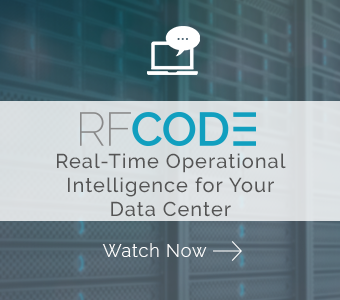Part 1: The Importance of Asset Management, Monitoring, and Data Utilization
The term “Real-Time Operational Intelligence” or RTOI is beginning to gain traction in a variety of technology and business verticals, but it’s an idea that RF Code has been developing for years. At its most basic, RTOI is a concept whereby businesses are able to take incredibly large amounts of data and quickly convert it into informed and intelligent actions. As you might expect, the benefits of properly executed RTOI are great: immediate response to potential threats before they can cause downtime, ongoing improvements made to increase optimization (with low staff hours needed for tasks like data analysis), and the ability to take vast amounts of data and funnel them through one channel for ease of interpretation. Like many other methods of operational improvement in the data center industry, RTOI has also been evolving to meet a variety of needs.
 Whether your goals are improved capacity planning, accurate asset lifecycle management, regulatory compliance or optimized power and cooling efficiency, as the old data center maxim goes: you can’t manage what you don’t measure and you can’t measure what you don’t monitor. Going back to some of RF Code’s most popular offerings, asset management is a field that has been ripe for enhancement through RTOI. At its outset, simply having the ability to track equipment for inventory and security reasons through wire-free sensors and asset tags was a major innovation. As is the case with all innovations, a good idea that was once groundbreaking eventually became the industry standard.
Whether your goals are improved capacity planning, accurate asset lifecycle management, regulatory compliance or optimized power and cooling efficiency, as the old data center maxim goes: you can’t manage what you don’t measure and you can’t measure what you don’t monitor. Going back to some of RF Code’s most popular offerings, asset management is a field that has been ripe for enhancement through RTOI. At its outset, simply having the ability to track equipment for inventory and security reasons through wire-free sensors and asset tags was a major innovation. As is the case with all innovations, a good idea that was once groundbreaking eventually became the industry standard.
The next logical evolution in responsive real-time asset management and data center administration comes from the continuous flow of abundant and accurate asset location data through the use of RTOI-based solutions. As a result, RF Code began the process of enhancing its award-winning wire-free instrumentation technology, ultimately leading to a solution that gives data center owners and operators real-time visibility into the location of their IT assets and the environmental conditions that surround them. Additionally, the company developed asset tags that provide the continuous asset location visibility that is critical to intelligent change and capacity management, optimal data center efficiency, and improved total cost of ownership (TCO), spanning delivery, deployment, and eventually disposal. Wire-free environmental sensors also evolved to provide data center managers with the visibility and granularity needed to fine-tune conditions within the data center. From the facility level to the rack microenvironment, the RF Code sensor network delivers real-time data about the environment surrounding data center assets, preventing downtime and ensuring data center efficiency.
With these advanced tools available, the final step in creating a modern RTOI solution was the development of a software system that ties the abundance of information provided by sensors and tags together into a format that fosters informed and intelligent decisions. The answer was RF Code’s CenterScape. Launched in 2015 as a complete, end-to-end solution for data centers, CenterScape provides real-time insight, control and predictability over operational risks, costs, and compliance-- enabling owners and operators to address their most difficult data center design, management and operational challenges. In addition to the asset management and environmental monitoring that end-users have come to expect from a robust solution, CenterScape took leaps forward with data center RTOI. It utilizes an intelligent data normalization engine which allows data center operators to interpret, offer recommendations and make informed decisions from the vast amounts of data that have been collected. This applies on a variety of levels:
- Gaining a better understanding of asset status to effectively plan, manage and predict future operational needs.
- The ability to be aware of and manage potential risks associated with high-value assets, reduce infrastructure or service downtime and reduce expenses due to over- or under-cooling.
- Plan and manage infrastructure capacity to better utilize existing resources and eliminate unnecessary expenses.
- Analyze current and historical trends while predicting future probabilities, allowing for rapid identification of growing threats to the data center or opportunities to increase operational efficiency.
Thanks to the combination of powerful asset management and monitoring tools with a platform that can interpret the ever-changing and voluminous amounts of information they convey, data center operators are now able to quickly make decisions that will increase efficiency and optimization, allowing for better conditions in the current while effectively planning for the future. Ultimately, with the evolution of Real-Time Operational Intelligence in the data center, we are finally able to move beyond the facility and advance at the speed of business.
Next up: The Evolution of Real-Time Operational Intelligence Part 2: RTOI expands into the Cloud. Coming soon!




